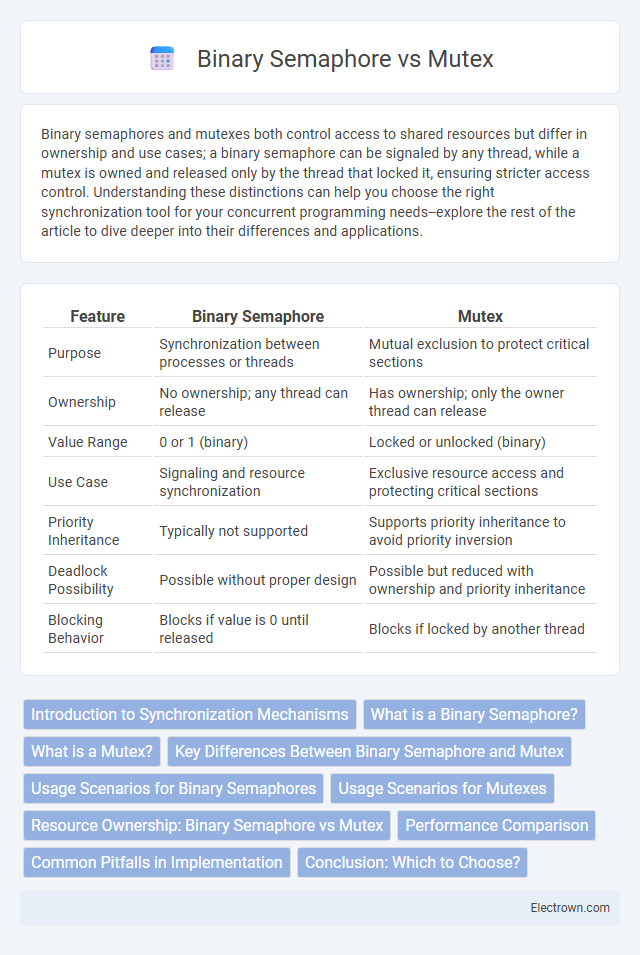Binary semaphores and mutexes both control access to shared resources but differ in ownership and use cases; a binary semaphore can be signaled by any thread, while a mutex is owned and released only by the thread that locked it, ensuring stricter access control. Understanding these distinctions can help you choose the right synchronization tool for your concurrent programming needs--explore the rest of the article to dive deeper into their differences and applications.
Table of Comparison
| Feature | Binary Semaphore | Mutex |
|---|---|---|
| Purpose | Synchronization between processes or threads | Mutual exclusion to protect critical sections |
| Ownership | No ownership; any thread can release | Has ownership; only the owner thread can release |
| Value Range | 0 or 1 (binary) | Locked or unlocked (binary) |
| Use Case | Signaling and resource synchronization | Exclusive resource access and protecting critical sections |
| Priority Inheritance | Typically not supported | Supports priority inheritance to avoid priority inversion |
| Deadlock Possibility | Possible without proper design | Possible but reduced with ownership and priority inheritance |
| Blocking Behavior | Blocks if value is 0 until released | Blocks if locked by another thread |
Introduction to Synchronization Mechanisms
Binary semaphores and mutexes are fundamental synchronization mechanisms used to manage access to shared resources in concurrent programming. Binary semaphores operate as signaling tools that can take only two values, enabling or blocking access without ownership enforcement. Mutexes, or mutual exclusion locks, provide exclusive access by allowing only the lock holder to enter the critical section, ensuring both access control and ownership management.
What is a Binary Semaphore?
A Binary Semaphore is a synchronization primitive used in concurrent programming to manage access to shared resources, allowing only two states: locked or unlocked. Unlike a mutex, which is owned by the thread that locks it and supports recursive locking, a binary semaphore does not have ownership semantics and can be signaled by any thread. Your system benefits from binary semaphores when you need simple signaling mechanisms without the overhead or ownership constraints of mutexes.
What is a Mutex?
A mutex, or mutual exclusion lock, is a synchronization primitive used to control access to a shared resource in concurrent programming, ensuring that only one thread can access the resource at a time. Unlike a binary semaphore, a mutex provides ownership, meaning the thread that locks the mutex must be the one to unlock it, preventing accidental release by other threads. Your application benefits from using a mutex when strict thread ownership and protection against race conditions are essential for data integrity.
Key Differences Between Binary Semaphore and Mutex
Binary semaphores and mutexes both serve synchronization purposes but differ primarily in ownership and usage scope. A binary semaphore can be signaled by any task or interrupt, making it suitable for signaling events, while a mutex is owned by the thread that locks it and is designed to provide mutual exclusion for critical sections. Understanding these key differences helps you choose the appropriate synchronization mechanism for ensuring thread-safe operations in concurrent programming.
Usage Scenarios for Binary Semaphores
Binary semaphores are primarily used for signaling between tasks or interrupt service routines in real-time operating systems, enabling synchronization without enforcing ownership restrictions. They excel in scenarios where tasks need to wait for events or conditions to proceed, such as resource availability or task completion notifications. Unlike mutexes, binary semaphores do not provide priority inheritance, making them suitable for simpler synchronization where mutual exclusion is not strictly required.
Usage Scenarios for Mutexes
Mutexes are primarily used in scenarios requiring exclusive access to a shared resource, ensuring that only one thread can access the critical section at a time. Ideal for protecting data structures, preventing race conditions, and managing resource allocation in multithreaded applications, mutexes provide robust synchronization. You benefit from mutexes when coordinating complex thread interactions and maintaining data integrity in concurrent programming environments.
Resource Ownership: Binary Semaphore vs Mutex
Binary semaphores do not have strict ownership rules, allowing any task to release the semaphore regardless of which task acquired it, potentially causing synchronization issues. Mutexes enforce strict ownership, ensuring only the task that locked the mutex can release it, preventing priority inversion and enhancing resource protection. This ownership distinction makes mutexes more suitable for managing exclusive access to shared resources in real-time operating systems.
Performance Comparison
Binary semaphores and mutexes both manage access to shared resources, but mutexes often offer better performance due to their design for mutual exclusion with ownership and priority inheritance. Binary semaphores can lead to higher overhead since they do not enforce ownership, resulting in potential context switches and increased latency under contention. In real-time systems, mutexes minimize priority inversion and reduce synchronization delays, making them more efficient for performance-critical applications.
Common Pitfalls in Implementation
Binary semaphore and mutex are synchronization tools that prevent race conditions but differ in ownership and usage patterns. Common pitfalls include incorrect usage of binary semaphores as mutexes, leading to priority inversion and deadlocks, and failing to release mutexes properly, which can cause resource starvation. To avoid these issues, ensure that your implementation respects ownership for mutexes and uses binary semaphores strictly for signaling without ownership constraints.
Conclusion: Which to Choose?
Binary semaphores and mutexes both serve synchronization purposes in concurrent programming, but their use cases differ significantly. A mutex provides ownership and is best suited for protecting shared resources, ensuring only the thread that locked it can unlock it, while binary semaphores allow signaling between threads without ownership constraints. You should choose a mutex when strict resource access control and deadlock prevention are priorities, and opt for a binary semaphore to manage event signaling or resource counting scenarios.
Binary Semaphore vs Mutex Infographic

 electrown.com
electrown.com